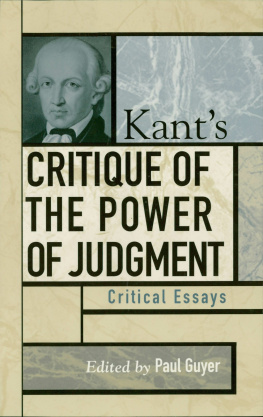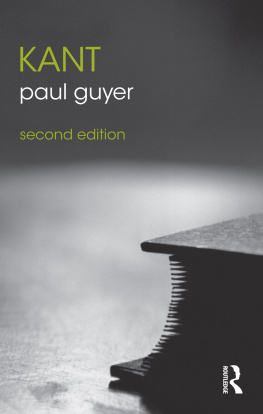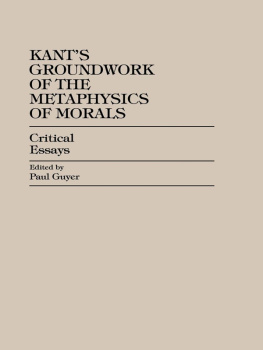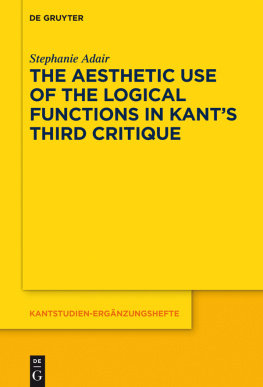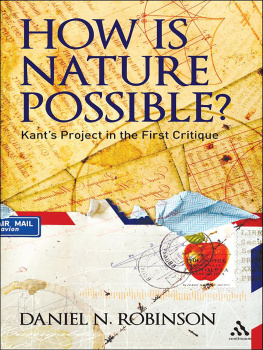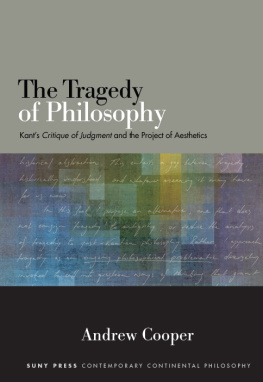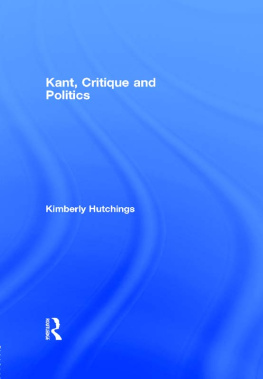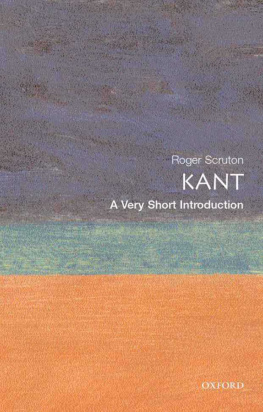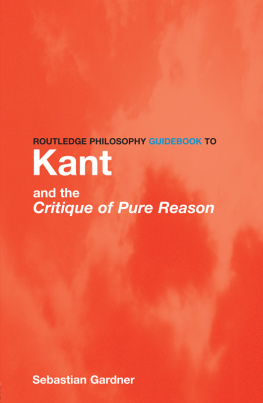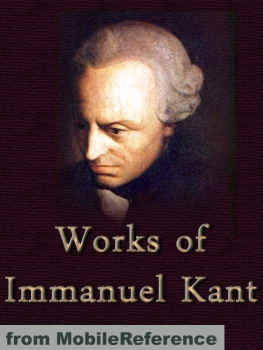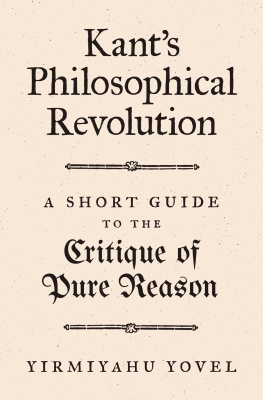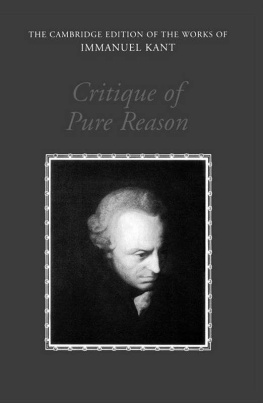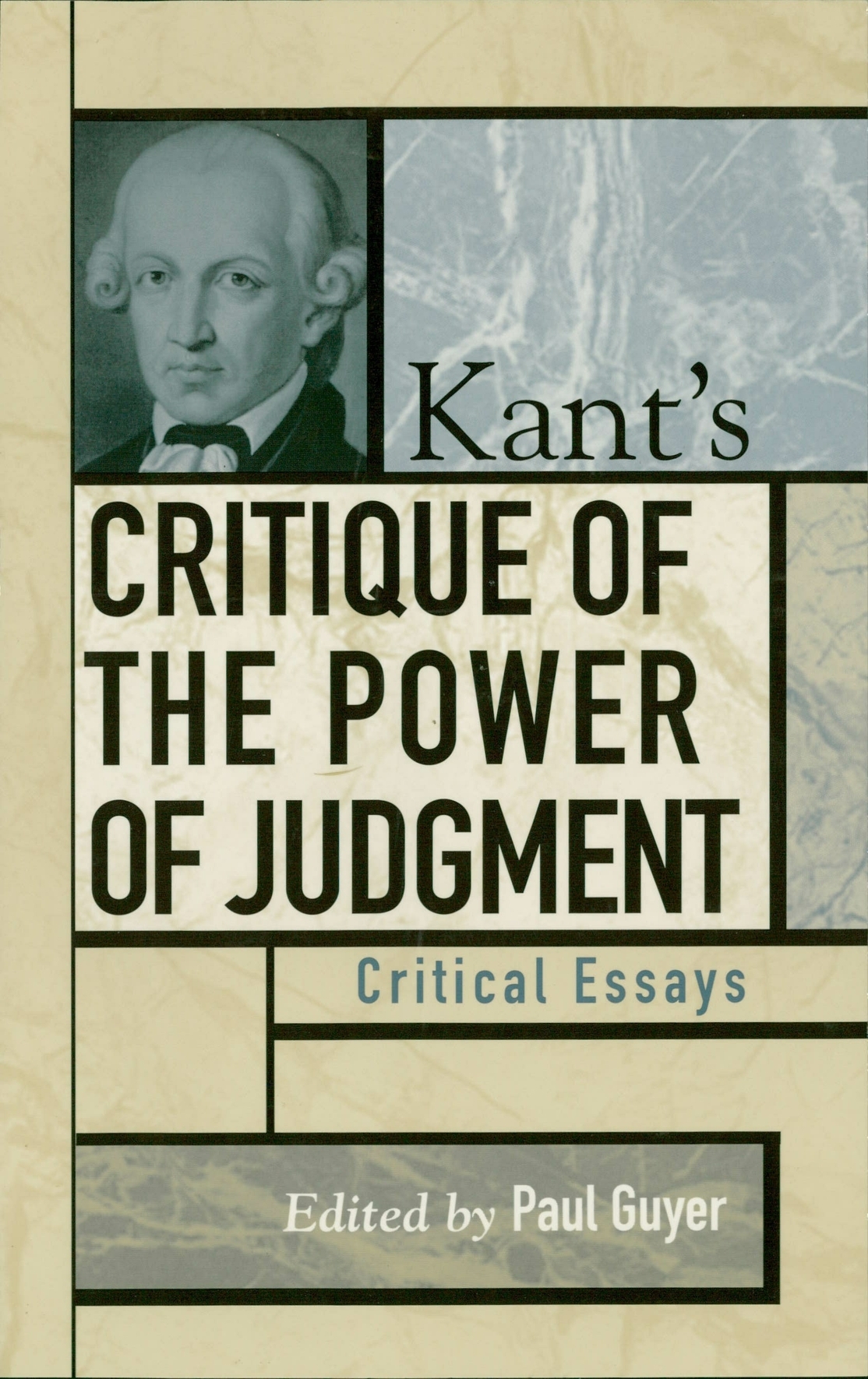Kant, Immanuel. Critik der Urtheilskraft. Berlin and Libau: Lagarde and Friedrich, 1790.
. Critik der Urtheilskraft . Zweyte Auflage (second edition). Berlin: F. T. Lagarde, 1793. Kant made numerous small changes in wording and punctuation for the second edition, which is the basis for modern editions.
Modern Editions
Kant, Immanuel. Kritik der Urtheilskraft. Edited by Wilhelm Windelband. Volume 5 of Kants gesammelte Schriften, edited by the Royal Prussian Academy of Sciences. Berlin: Georg Reimer, 1913, pp. 165485. The pagination of this edition is cited in all but the earliest of the English translations listed here; it is also used for page references in most secondary literature.
. Erste Einleitung in die Kritik der Urteilskraft. Edited by Gerhard Lehmann. Volume 20 of Kants gesammelte Schriften, edited by the Prussian Academy of Sciences. Berlin: Walter de Gruyter, 1942, pp. 193251.
. Kritik der Urteilskraft. Edited by Gerhard Lehmann. Stuttgart: Philipp Reclam June 1963. Conveniently collates the variations between Kants first two editions of the work.
. Kritik der Urteilskraft; Schriften zur Asthetik und Naturphilosophie. Edited by Manfred Frank and Vronique Zanetti. Frankfurt am Main: Deutscher Klassiker Verlag, 1996. Includes a variety of Kants other scientific writings as well as the First Introduction and a selection from Kants notes on aesthetics.
. Kritik der Urteilskraft. Edited by Heiner F. Klemme, with notes by Piero Giordanetti. Hamburg: Felix Meiner Verlag, 2001. Includes a lengthy introduction, detailed notes, and an extensive bibliography.
ENGLISH TRANSLATIONS
Kant, Immanuel. Critique of Judgement. Translated by J. H. Bernard. London: Macmillan, 1892 (reprint, New York: Hafner, 1953). No longer widely used, but some of its terminology was clearer than that of the following.
. Kants Critique of Aesthetic Judgement. Translated, with an introduction, notes, and analytical index, by James Creed Meredith. Oxford, U.K.: Clarendon Press, 1911.
. Kants Critique of Aesthetic Judgement. Translated, with an introduction, notes, and analytical index, by James Creed Meredith. Oxford, U.K.: Clarendon Press, 1928. These two volumes were combined into one, without most of the editorial material, as the following volume.
. Critique of Judgement. Translated with analytical indexes by James Creed Meredith. Oxford, U.K.: Clarendon Press, 1952. This volume was the standard English translation for most of the twentieth century.
. Analytic of the Beautiful, from the Critique of Judgment, with excerpts from Anthropology from a Pragmatic Point of View. Translated by Walter Cerf. Indianapolis: Bobbs-Merrill, 1963. The translation of just the Analytic of the Beautiful gives a misleading impression of Kants aesthetics, since it omits Kants theory of the sublime and of the fine arts. The translation of material on pleasure and taste from Kants Anthropology, however, is useful.
. First Introduction to the Critique of Judgment. Translated by James Haden. Indianapolis: Bobbs-Merrill, 1965. For many years, the only available translation of this important text, now superseded by the following two translations.
. Critique of Judgment, Including the First Introduction. Translated with an introduction by Werner S. Pluhar. Indianapolis: Hackett, 1987. The first English translation to include the First Introduction, this volume also contains the translators monograph-length interpretation of Kants work. Readers may find the frequent editorial insertions in Kants text distracting.
. Critique of the Power of Judgment. Edited by Paul Guyer, translated by Paul Guyer and Eric Matthews. Cambridge, U.K.: Cambridge University Press, 2000. This edition also includes the First Introduction. Its notes offer extensive cross-references to Kants fragments on aesthetics and the recently published lectures on anthropology.
GENERAL WORKS ON KANT AND ON THE HISTORICAL CONTEXT OF THE CRITIQUE OF THE POWER OF JUDGMENT
Arendt, Hannah. Lectures on Kants Political Philosophy. Edited by Ronald Beiner. Chicago: University of Chicago Press, 1982. Controversially argues that Kants concept of aesthetic judgment is the basis for his political theory.
Baeumler, Alfred. Das Irrationalittsproblem in der sthetik und Logik des 18. Jahrhunderts bis zur Kritik der Urteilskraft. 2nd edition. Tbingen: Max Niemeyer, 1967 (original edition: 1923). By a philosopher who later disgraced himself as a Nazi apologist, whose attraction to irrationalism was already evident in this work, it nevertheless remains a valuable source for studying the roots of Kants aesthetics in eighteenth-century thought.
Beck, Lewis White. Early German Philosophy: Kant and His Predecessors. Cambridge, Mass.: Harvard University Press, 1969. A detailed study of German philosophy from the middle ages to Kant, including several chapters on eighteenth-century German aesthetics.
Budd, Malcom. Values of Art: Pictures, Poetry and Music. London: Allen Lane/Penguin Press, 1995. Considers Kants contribution to discussions of aesthetic value and of particular arts.
Cassirer, Ernst. The Philosophy of the Enlightenment. Translated by Fritz C. A. Koelln and James P. Pettegrove. Princeton, N.J.: Princeton University Press, 1951. Includes a detailed study of European aesthetics before Kant.
. Kants Life and Thought. Translated by James Haden. New Haven, Conn.: Yale University Press, 1981. Originally published in 1918, this was the neo-Kantian Cassirers most extensive treatment of Kant, and its ninety pages on the Critique of the Power of Judgment situates Kants third critique in his larger system.
Caygill, Howard. Art of Judgment. Oxford, U.K.: Blackwell, 1989. Relates Kants conception of judgment to eighteenth-century political theory as well as aesthetics.
Derrida, Jacques. The Truth in Painting. Translated by Geoff Bennington and Ian McLeod. Chicago: University of Chicago Press, 1987. Includes Derridas notorious deconstructive interpretation, arguing that Kants concept of the parergon (frame) undermines any distinction between art and nonart.
Dickie, George. The Century of Taste: The Philosophical Odyssey of Taste in the Eighteenth Century. New York: Oxford University Press, 1996. Argues for the superiority of Humes aesthetics to Kants, in part on the basis of the questionable claim that Kants concept of beauty depends upon his concept of the purposiveness of organisms.
Dumouchel, Daniel. Kant et la Gense de la Subjectivite Esthtique. Paris: Vrin, 1999. An important work on both the background and the development of Kants aesthetics.
Ferry, Luc. Homo Aestheticus: The Invention of Taste in the Democratic Age . Translated by Robert de Loaiza. Chicago: University of Chicago Press, 1993. Associates the rise of modern aesthetics with the development of political liberalism, situating Kant squarely in this development.
Frster, Eckart, ed. Kants Transcendental Deduction: The Three Critiques and the Opus postumum. Stanford, Calif.: Stanford University Press, 1989. Contains a debate between the German scholars Reinhard Brandt and Rolf-Peter Horstmann on the necessity of a deduction in the third Critique . Also contains a famous discussion of Kants ethics by John Rawls.
Gadamer, Hans-Georg. Truth and Method . Translated by Garrett Barden and John Cumming. 2nd edition revised by Joel Weinsheimer and Donald G. Marshall. New York: Seabury Press, 1989. This 1960 work on hermeneutics, by the most important student of Martin Heidegger, begins with an influential argument that Kant subjectivized modern aesthetics by focusing on aesthetic experience rather than the work of art.

